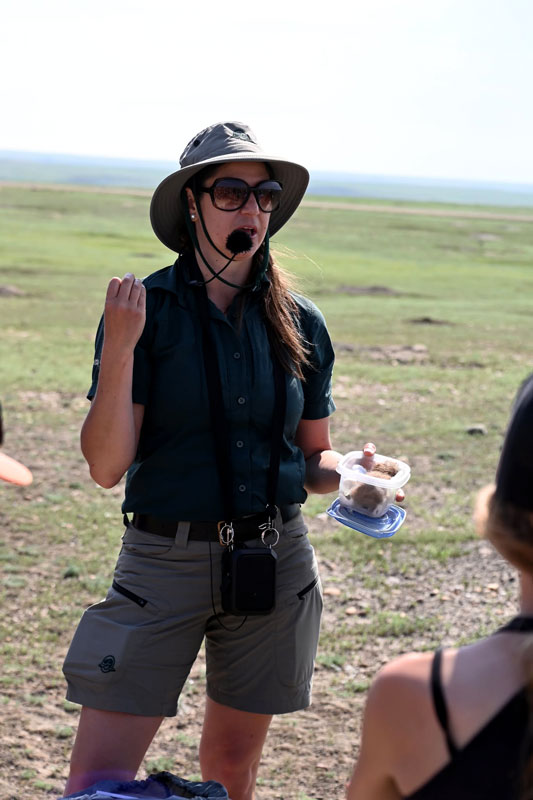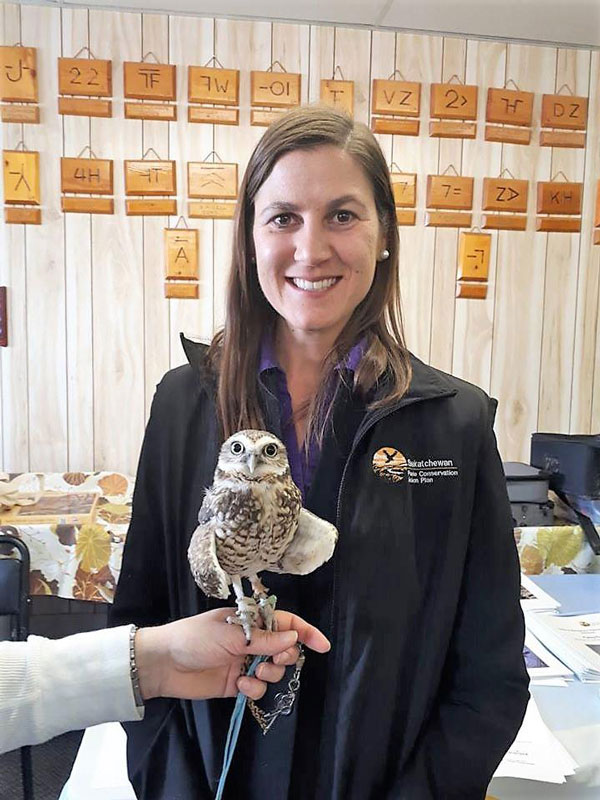
USask graduate committed to living sustainably and protecting prairie environments
Caitlin Mroz-Sailer (MSEM’11), who studied in USask’s School of Environment and Sustainability, is an entrepreneur, naturalist, heritage presenter, and stewardship coordinator
By SHANNON BOKLASCHUK“It was an incredible experience.”
That’s how University of Saskatchewan (USask) alumna Caitlin Mroz-Sailer (MSEM’11) describes her time as a graduate student in USask’s School of Environment and Sustainability (SENS). She pursued a Master of Sustainable Environmental Management degree at SENS, graduating from USask in 2011.
“When I went through the program, it was really unique at that time. It was one of the only schools to offer a multidisciplinary approach to the environment and that is so important in today’s world,” she said.

Mroz-Sailer grew up in London, Ont., and came to USask after earning a Bachelor of Science (honours) degree in biology at McMaster University. She chose SENS because she felt studying there would bring her closer to her goals of “being able to communicate important scientific research with the larger community” and making science more accessible to all.
“I thought the interdisciplinary approach would be beneficial in working with stakeholders, public communication, and partner collaboration,” she said.
Since her graduation, Mroz-Sailer’s USask education has been beneficial in her jobs at Parks Canada and the Saskatchewan Prairie Conservation Action Plan, as well as in her entrepreneurial pursuits. Mroz-Sailer currently resides in Val Marie, Sask., where she enjoys spending time hiking in Grasslands National Park and canoeing or kayaking at Newton Lake. As someone who is passionate about local and seasonable foods, Mroz-Sailer ran a small restaurant in Val Marie for more than five years. She and her husband have since started a business called The Sanctuary Inn, which offers vacation suites near Grasslands National Park.
“One of our main business goals is to do it sustainably,” she said. “We strive to reduce single-use plastics, to reduce our environmental footprint, and we even compost. Many skills and ideas I learned from SENS have helped this business be successful—and I am so grateful.”
The Green&White recently asked Mroz-Sailer about her time at USask, how her studies at SENS have been beneficial in her career, and what fuels her passion for sustainability.
Why did you choose to study at the University of Saskatchewan?
I had been working at Grasslands National Park for a couple of summers—2007 and 2008—and had fallen in love with the prairies and had become very passionate about prairie conservation. I spent eight months abroad—August 2008 to April 2009—and when I came back in 2009 to work at Grasslands National Park for a third season, I really wanted a to stay in the province. I learned about a very new program offered at the University of Saskatchewan through the School of Environment and Sustainability. I started there in September 2009, and I think I was in the second year of the program. It just felt like a good fit for me because I could do it part time while working part time at Grasslands. I also loved the campus and that I would continue to learn more about prairie ecosystems. Coming from a very science-focused undergrad, I was also attracted to the idea of learning from different perspectives that was offered with the interdisciplinary approach at SENS.
What was the best part of your graduate program?
I really liked my project. My project focused on the effectiveness of a citizen science volunteer monitoring program at Grasslands National Park for a species at risk, the black-footed ferret. Working with Dr. Douglas Clark (PhD), he gave me a lot of guidance to develop the project and analyze the program. I am a very independent person, and I felt that I had enough space to be independent but had advice and direction when I needed it. I learned really valuable skills about how to set up surveys, talk to citizen scientists about their experiences, and how to analyze that data. It has been very useful to me with my work at Saskatchewan Prairie Conservation Action Plan (SK PCAP). And, of course, seeing black-footed ferrets in the wild—one of North America’s most-endangered species—was pretty special!
What was your experience like in the School of Environment and Sustainability?
It was amazing to be surrounded by like-minded individuals, by people who also cared about single-use plastics and their impact on the environment. It was also really special to be surrounded by such a diversity of students. It was the first time in my life that I was able to hear about the environment from an Indigenous perspective and it really opened my eyes. I really connected with the other students and even went to China to visit a friend I had made there. I am still in touch with some professors and former students.
You are now employed with Parks Canada and SK PCAP. What are your roles?

I have been with Parks Canada since 2007 and worked in a variety of roles and assignments, but my primary role there is a heritage presenter. As a naturalist, I lead curriculum-linked outdoor education programs for classrooms. I also lead programs and events for the general public about the native prairie ecosystem and species at risk. It’s amazing, because I get to be outside and talking about what I love! I work for Parks Canada for about five to six months of every year. Over the years, I have done assignments related to restoration projects (seed collecting and cleaning), species-at-risk monitoring (prairie dog colony perimeter mapping, burrowing owls), and active management (marking fence lines for greater sage-grouse and applying an insecticide to prevent a wildlife disease for prairie dogs).
In the off-season, I also work for Saskatchewan Prairie Conservation Action Plan (SK PCAP), which is a sub-committee of the Saskatchewan Stock Growers Association. Since 2011, I have been working as a stewardship coordinator there and I do public awareness activities, small and large events, as well social media campaigns about species at risk and the importance of protecting the prairies. I am most passionate about a monthly Native Prairie Speaker Series webinar, which brings in an expert speaker to talk about a specific species. I have hosted over 200 webinars. I know it is a little unconventional to work at two different places over the year, but I have been doing it for almost 15 years, and it works for me. I am grateful for year-round employment in the field of environment. And it also gives me some extra vacation time to allow me to pursue other passions, like travelling.
How has your education at SENS been of benefit in the workplace and in your career?
So many ways! I took a course that I remember as an environmental history course and we read a book a week. It was incredible the amount of information that we learned, but it gave me such a great background for my work. I also took a course in environmental restoration and with my work with SK PCAP, I have been involved in planning the Native Prairie Restoration/Reclamation Workshop 10 times. That course gave me great background information that I still use. We had so many great class discussions and I will always remember other students feeling open to share their ideas, thoughts, and perspectives.
What fuels your passion for sustainability and the environment?
It’s always been there. When I was little, I spent a lot of time outside with my parents, who taught me about fishing, hiking, and camping. I was a “junior naturalist” at Bruce Peninsula National Park when I was four years old. I also participated in the Girl Guides of Canada programs for over a decade, which helped foster it. With my work at Grasslands now, I get inspired daily by taking kids out into the prairie and showing them a beautiful prairie wildflower or a rare short-horned lizard. It’s amazing how excited they get, and they make it special for me.



